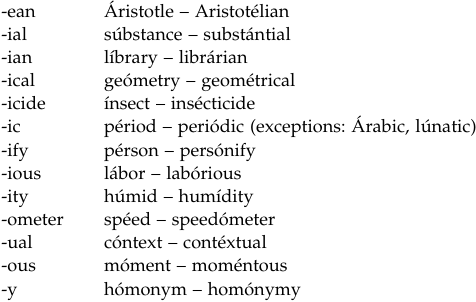

Grammar


Tenses


Present

Present Simple

Present Continuous

Present Perfect

Present Perfect Continuous


Past

Past Continuous

Past Perfect

Past Perfect Continuous

Past Simple


Future

Future Simple

Future Continuous

Future Perfect

Future Perfect Continuous

Passive and Active


Parts Of Speech


Nouns

Countable and uncountable nouns

Verbal nouns

Singular and Plural nouns

Proper nouns

Nouns gender

Nouns definition

Concrete nouns

Abstract nouns

Common nouns

Collective nouns

Definition Of Nouns


Verbs

Stative and dynamic verbs

Finite and nonfinite verbs

To be verbs

Transitive and intransitive verbs

Auxiliary verbs

Modal verbs

Regular and irregular verbs

Action verbs


Adverbs

Relative adverbs

Interrogative adverbs

Adverbs of time

Adverbs of place

Adverbs of reason

Adverbs of quantity

Adverbs of manner

Adverbs of frequency

Adverbs of affirmation


Adjectives

Quantitative adjective

Proper adjective

Possessive adjective

Numeral adjective

Interrogative adjective

Distributive adjective

Descriptive adjective

Demonstrative adjective


Pronouns

Subject pronoun

Relative pronoun

Reflexive pronoun

Reciprocal pronoun

Possessive pronoun

Personal pronoun

Interrogative pronoun

Indefinite pronoun

Emphatic pronoun

Distributive pronoun

Demonstrative pronoun


Pre Position


Preposition by function

Time preposition

Reason preposition

Possession preposition

Place preposition

Phrases preposition

Origin preposition

Measure preposition

Direction preposition

Contrast preposition

Agent preposition


Preposition by construction

Simple preposition

Phrase preposition

Double preposition

Compound preposition


Conjunctions

Subordinating conjunction

Correlative conjunction

Coordinating conjunction

Conjunctive adverbs


Interjections

Express calling interjection


Grammar Rules

Preference

Requests and offers

wishes

Be used to

Some and any

Could have done

Describing people

Giving advices

Possession

Comparative and superlative

Giving Reason

Making Suggestions

Apologizing

Forming questions

Since and for

Directions

Obligation

Adverbials

invitation

Articles

Imaginary condition

Zero conditional

First conditional

Second conditional

Third conditional

Reported speech


Linguistics

Phonetics

Phonology


Semantics


Pragmatics

Linguistics fields

Syntax

Morphology

Semantics

pragmatics

History

Writing

Grammar

Phonetics and Phonology


Reading Comprehension

Elementary

Intermediate

Advanced


Teaching Methods

Teaching Strategies
Stress-shifting (fixing) suffixes
المؤلف:
Mehmet Yavas̡
المصدر:
Applied English Phonology
الجزء والصفحة:
P166-C7
2025-03-15
260
Stress-shifting (fixing) suffixes
A multiplicity of derivational suffixes, when added to a root, shift the stress from its original position to the syllable immediately preceding the suffix. Below are some of the common ones in this group:

We need to point out that if the original stress is on the last syllable of the root (the syllable immediately before the suffix), no change in location of the stress will result, because it is already where it should be (e.g. divérse– divérsify, absúrd– absúrdity, obése– obésity).
There is also a group of suffixes that put the stress on the syllable immediately before them if that syllable is heavy (i.e. has branching rhyme). The suffix-al in refusal, recital, and accidental is an example of this phenomenon. The stress falls on the syllable that is immediately before the suffix, because that syllable is heavy (long vowel, diphthong, and closed syllable, respectively). However, if the syllable in question is not heavy, then the stress moves one more syllable to the left (e.g. séasonal, práctical). The same is observable in the suffix -ency of emérgency and consístency on the one hand, and présidency and cómpetency on the other. While in the first two words the stress is on the syllable immediately before the suffix (closed syllable), it falls on the syllable one more position to the left in the last two words because the syllable before the suffix is light.
It is worth pointing out that there are some other endings that seem to vacillate between the different suffix types, of which -able is a good example. This suffix behaves like stress-neutral suffixes in most cases, as in quéstion quéstionable, adóre– adórable, mánage– mánageable. However, in several disyllabic stems with final stress, it shifts the stress one syllable left (to stem initial), as in admíre– ádmirable, compáre– cómparable, prefér– préferable (however, note the more recent tendency to stress-neutral behavior, e.g. compárable, admírable). To complicate things further, -able may also shift the stress one syllable to the right, as in démonstrate– demónstrable.
Another interesting case is the -ive suffix. When added to a monosyllabic root, the stress, expectedly, is on the root (-ive cannot bear stress) as in áct - áctive. However, in words with three or more syllables, we may see the stress falling on the syllable before it (e.g. decísive, offénsive), or moving one more to the left (e.g. négative, sédative), or even to one further left (e.g. génerative , méditative). There are attempts to separate cases such as decisive, offensive, etc. from others by stating that in these the roots are preceded by prefixes. Such explanations, although historically justifiable, are very dubious synchronic ally, and will not be followed here.
We can also point out that the classification has nothing to do with the morphological division of inflectional and derivational suffixes. While the eight inflectional suffixes:

do not have any effect on the stress (i.e. the addition of these suffixes does not change the location of the stress), derivational suffixes have no such predictability. As we saw in several examples above, while they may stay neutral to the stress, e.g. bottom– bottomless [bɑ́ɾəm] – [bɑ́ɾəmləs], they can shift the stress, e.g. geography – geographic [ʤiɑ́gɹ̣əfi] – [ʤiəgɹ̣ǽfək], or even carry the stress themselves, e.g. lemon– lemonade [lέmən] – [lεmənéd].